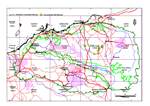Click on images
to enlarge


, BRM 8100, ORIGINAL SCAN, ADJUSTED RICHARD WOODMAN_sml.jpg)
Photographer: B.R. Maslin
, BRM 8100, ORIGINAL SCAN, ADJUSTED RICHARD WOODMAN_sml.jpg)
Photographer: B.R. Maslin

Photographer: B.R. Maslin

Photographer: J. Maslin
, BRM 8662, lab photo by Fiona McCallum ADJUSTED_sml.jpg)
Seed from one herbarium voucher. Scale in mm. Photographer: F. McCallum.
Botanical name
Acacia levata Cowan & Maslin, Nuytsia 10: 41 (1995)
Common name
Woodstock Wattle
Description
Spreading shrubs 1-3 m tall, 'v'-shaped, branching at ground level into a number of spreading-erect, slightly crooked main stems, with rounded crowns which are bushy, dark green and 1.5-5 m across, some old plants have a slightly gnarled appearance (not dissimilar to A. xiphophylla or A. cuthbertsonii). Bark grey to blackish, longitudinally fissured and fibrous towards base of mature stems, usually becoming smooth towards ends of branches. Branchlets sometimes glabrous but normally sericeous at extremities. New shoots citron-sericeous, with a silvery sheen. Phyllodes narrowly elliptic to oblong-elliptic, 8-13.5 cm long, 10-20 mm wide, thick and leathery, straight to shallowly curved, invested with a layer of minute, silvery white, appressed hairs which are not apparent to the unaided eye, dark green to sub-glaucous with a silvery sheen (green or somewhat glaucous on young plants); with about 4-6 widely spaced, prominent main longitudinal nerves and longitudinally-anastomosing minor nerves between them; apex obtuse to acute. Inflorescences simple, 1 to several within axil of phyllodes; peduncles 5-12 mm long, glabrous or appressed -hairy; spikes golden, 15-35 mm long, the flowers close together or rather widely spaced. Flowers 5-merous; sepals ½-¾-united. Pods pendulous, linear, neither raised over nor constricted between seeds, 7-15 cm long, 7-12 mm wide, woody, straight to slightly curved, glabrous, coarsely longitudinally wrinkled, straw-coloured (brownish yellow); margins with a narrow, vertical wing -like structure, 1-2 mm wide on either side of the suture. Seeds longitudinal in the pods, widely ellipsoid to nearly globose, 5-5.5 mm long, flattened, dull, dark brown; the central areole slightly raised and slightly shiny.
Characteristic features
Spreading shrubs, sometimes with a Snakewood growth habit. Phyllodes broad (10-20 mm wide), thick and leathery, dark green to sub-glaucous with a silvery sheen, with prominent, longitudinally anastomosing nerves. Inflorescences spicate. Pods linear, woody, glabrous, drying yellowish brown and slightly wrinkled, margins narrowly winged.
Distribution and ecology
Restricted to the Pilbara region in northwest WesternAustralia where it is known from only a restricted area south of Marble Bar. It is common in the places where it occurs sometimes forming extensive thickets. Grows with spinifex in gently undulating, low rocky hills (often associated with seasonally dry watercourses), on shallow sand, sandy loam or clay-loam (pH 7-8.5) over granite or quartz. Common associates are A. hilliana and A. stellaticeps.
Flowering and fruiting period
Because of the paucity of collections it is difficult to be precise about the phenology of this species. However, flowers have been collected in late May (and judging from these it is likely that flowering would extend to about July) and pods with mature seeds from mid-October to early November.
Affinities
Related to A. cuthbertsonii subsp. cuthbertsonii which appears not to occur in the Pilbara (see Note below) and which is most readily distinguished from A. levata by its more obviously hairy phyllodes which are generally smaller (3-8.5 cm long and normally 3-10 mm wide) and less prominently nerved, broader pods (11-22 mm wide) and larger seeds (7.5-9 mm long). Some old plants of A. levata may have a slight Snakewood growth form, thus superficially resembling a small plant of A. xiphophylla (which also has rather large, broad phyllodes and spicate inflorescences). Acacia xiphophylla , however, is readily recognized by its phyllode nerves which are much finer (scarcely visible to the unaided eye), more numerous, closer together and not anastomosing, by its more thinly textured pods that are darker coloured, not wrinkled and which do not have winged margins.
Note: There exists at the W.A. Herbarium one specimen of A. cuthbertsonii subsp. cuthbertsonii ostensibly collected in the "Hamersley Range" by P. McMillan in September 1958. However, we have not been able to verify this record, despite intensive collecting activity in the Hamersley Range over the past 20 years or so. All other collections of subsp. cuthbertsonii are from areas to the south and east of the Pilbara, and for now this subspecies will be considered as not occurring within the region.
Conservation status
Acacia levata is classified as a Priority 3 species on the Department of Environment and Conservation's Declared Rare and Priority Flora List.
Origin of name
The botanical name is derived from the Latin levatus (raised or elevated) and refers to the more strongly raised nervature of the phyllodes than is characteristic of related taxa. The common name reflects the occurrence of most populations of A. levata on the Woodstock-Abydos Reserve, a reserve vested primarily for the purposes of 'preservation of Aboriginal cultural materials' with the Mumbultjari Aboriginal Corporation.
